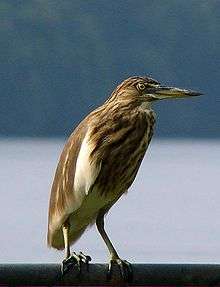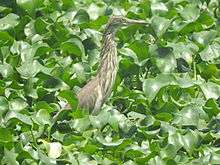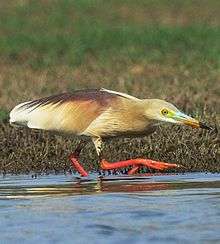Indian pond heron
| Indian pond heron | |
|---|---|
 | |
| In non-breeding plumage (Sri Lanka) | |
 | |
| Breeding plumage in (Kolkata, India) | |
| Scientific classification | |
| Kingdom: | Animalia |
| Phylum: | Chordata |
| Class: | Aves |
| Order: | Pelecaniformes |
| Family: | Ardeidae |
| Genus: | Ardeola |
| Species: | A. grayii |
| Binomial name | |
| Ardeola grayii (Sykes, 1832) | |
 | |
| Synonyms | |
|
Ardeola leucoptera | |
The Indian pond heron or paddybird (Ardeola grayii) is a small heron. It is of Old World origins, breeding in southern Iran and east to Pakistan, India, Burma, Bangladesh and Sri Lanka. They are widespread and common but can be easily missed when they stalk prey at the edge of small water-bodies or even when they roost close to human habitations. They are however distinctive when they take off with bright white wings flashing in contrast to the cryptic streaked olive and brown colours of the body. Their camouflage is so excellent that they can be approached closely before they take to flight, a behaviour which has resulted in folk names and beliefs that the birds are short-sighted or blind.[2][3]
Description
_in_Breeding_plumage_walking_cautiously_in_Kolkata_I_IMG_7936.jpg)

They appear stocky with a short neck, short thick bill and buff-brown back. In summer, adults have long neck feathers. Its appearance is transformed from their dull colours when they take to flight, when the white of the wings makes them very prominent. It is very similar to the squacco heron, Ardeola ralloides, but is darker-backed. To the east of its range, it is replaced by the Chinese pond heron, Ardeola bacchus.
During the breeding season, there are records of individuals with red legs. The numbers do not suggest that this is a normal change for adults during the breeding season and some have suggested the possibility of it being genetic variants.[4][5][6][7]
Erythristic plumage has been noted.[8] The race phillipsi has been suggested for the populations found in the Maldives, however this is not always recognized.[9] It forms a superspecies with the closely related Chinese pond heron, Javan pond heron and the Madagascar pond heron.
They are usually silent but may give a harsh croak when flushed or near their nests.[9]
This bird was first described by Colonel W. H. Sykes in 1832 and given its scientific name in honour of John Edward Gray. Karyology studies indicate that pond herons have 68 chromosomes (2N).[10]
Behaviour and ecology

They are very common in India, and are usually solitary foragers but numbers of them may sometimes feed in close proximity during the dry seasons[11] when small wetlands have a high concentration of prey. They are semi-colonial breeders. They may also forage at garbage heaps. During dry seasons, they sometimes take to foraging on well watered lawns or even dry grassland. When foraging, they allow close approach and flush only at close range. They sometimes form communal roosts, often in avenue trees over busy urban areas.[12]
Food and feeding


The Indian pond heron's feeding habitat is marshy wetlands. They usually feed at the edge of ponds but make extensive use of floating vegetation such as water hyacinth to access deeper water. They may also on occasion swim on water or fish from the air and land in deeper waters.[13][14][15][16] They have also been observed to fly and capture fishes leaping out of water.[17] [18] Sometimes, they fly low over water to drive frogs and fishes towards the shore before settling along the shoreline.[19]
The primary food of these birds includes crustaceans, aquatic insects, fishes, tadpoles and sometimes leeches (Herpobdelloides sp.).[20] Outside wetlands, these herons feed on insects (including crickets, dragonflies[21] and bees[22]), fish (Barilius noted as important in a study in Chandigarh) and amphibians.[23]
Breeding


The breeding season begins with the onset of the monsoons. They nest in small colonies, often with other wading birds, usually on platforms of sticks in trees or shrubs. Most nests are built at a height of about 9 to 10 m in large leafy trees. The nest material is collected by the male while the female builds the nest. Three to five eggs are laid.[24] The eggs hatch asynchronously, taking 18 to 24 days to hatch. Both parents feed the young.[25] Fish are the main diet fed to young.[11] Nest sites that are not disturbed may be reused year after year.[26]
Movements
Nocturnal movements of pond herons have been noted along the coast near Chennai.[27]
Mortality factors
They have few predators but injured birds may be taken by birds of prey.[28]
An arbovirus "Balagodu", trematodes[29] and several other parasites have been isolated from the species.[30][31][32][33][34] Antibodies to Japanese encephalitis and West Nile virus has been detected in pond herons and cattle egrets from southern India.[35] Traces of heavy metals acquired from feeding in polluted waters may be particularly concentrated in the tail feathers.[36]
In culture
_feedingin_drying_sewage_pond_in_Kolkata_I_IMG_7980.jpg)
_at_Narayanganj%2C_Bangladesh.jpg)
The habit of standing still and flushing only at the last moment has led to widespread folk beliefs that they are semi-blind and their name in many languages includes such suggestions. In Sri Lanka the bird is called kana koka which translates as "half-blind heron" in the Sinhala language.[2] The phrase "bagla bhagat" has been used to describe a "wolf in sheep's clothing" or a heron appearing like a meditating saint.[37]
During the height of the plume trade, feathers were collected from the "paddy bird" and exported to Britain.[38]
References
- ↑ BirdLife International (2012). "Ardeola grayii". IUCN Red List of Threatened Species. Version 2013.2. International Union for Conservation of Nature. Retrieved 26 November 2013.
- 1 2 Anonymous (1998). "Vernacular Names of the Birds of the Indian Subcontinent" (PDF). Buceros. 3 (1): 53–109.
- ↑ Yule, Henry; . Hobson-Jobson (1903). A glossary of colloquial Anglo-Indian words; phrases; of kindred terms, etymological, historical, geographical; discursive. New; William Crooke, B.A., eds. J. Murray, London http://dsal.uchicago.edu/cgi-bin/philologic/getobject.pl?c.1:1:728.hobson. Missing or empty
|title=(help) - ↑ Gopisundar, K. S. (2004). "Abundance and seasonality of Indian Pond Herons Ardeola grayii with red legs in Uttar Pradesh, India" (PDF). Forktail. 20.
- ↑ Abdulali, H. & Alexander, H. G. (1952). "Ardeidae with red legs". Ibis. 94 (2): 363. doi:10.1111/j.1474-919X.1952.tb01829.x.
- ↑ Wesley, H. D. (1993). "Genetics of the red tarsi and feet in the Pond Heron". Newsletter for Birdwatchers. 33 (4): 73.
- ↑ Sundar, Gopi KS. "Distribution and extent of Pond Herons Ardeola grayii with red legs in India" (PDF). Indian Birds. 1 (5): 108–115.
- ↑ Parasharya,BM (1983). "An erythristic pond heron". Pavo. 21 (1&2): 107–108.
- 1 2 Rasmussen, PC; JC Anderton (2005). Birds of South Asia:The Ripley Guide. Smithsonian Institution & Lynx Edicions.
- ↑ M. K. Mohanty; S. P. Bhunya (1990). "Karyological studies in four species of ardeid birds (Ardeldae, Ciconiiformes)". Genetica. 81 (3): 211–214. doi:10.1007/BF00360867.
- 1 2 Begum, S. (2003). "Colonial nesting behavior in Indian Pond Heron (Ardeola grayii grayii) of Bangladesh" (PDF). Zoos' Print Journal. 18 (6): 1113–1116. doi:10.11609/jott.zpj.18.6.1113-6.
- ↑ Gadgil, Madhav; Salim Ali (1975). "Communal roosting habits of Indian birds" (PDF). J. Bombay Nat. Hist. Soc. 72 (3): 716–727.
- ↑ Chandra-Bose,DA (1969). "The Paddybird, Ardeola grayii (Sykes) floating on water". Pavo. 7 (1&2): 74–75.
- ↑ Neelakantan,KK (1986). "Pond heron afloat". Newsletter for Birdwatchers. 26 (5–6): 11–13.
- ↑ Krishna, MB (1978). "Pond Herons". Newsletter for Birdwatchers. 18 (10): 10.
- ↑ Muir,GBF (1916). "Paddy-birds Ardeola grayii fishing". J. Bombay Nat. Hist. Soc. 24 (2): 366–367.
- ↑ Grimwood,IM; Brocklehurst,MJC (1984). "Unusual feeding behaviour in the Paddy Bird or Indian Pond Heron Ardeola grayii". J. Bombay Nat. Hist. Soc. 81 (3): 696–697.
- ↑ Sivasubramanian,C (1988). "Aerial feeding by Median Egret (Egretta intermedia), Little Egret (Egretta garzetta) and Pond Heron (Ardeola grayii)". J. Bombay Nat. Hist. Soc. 85 (3): 611–612.
- ↑ Kirkpatrick, K. M. (1953). "Feeding habit of the Indian Pond Heron (Ardeola grayii)". J. Bombay Nat. Hist. Soc. 51 (2): 507.
- ↑ Mathew,DN; Narendran,TC; Zacharias,VJ (1978). "A comparative study of the feeding habits of certain species of Indian birds affecting agriculture". J. Bombay Nat. Hist. Soc. 75 (4): 1178–1197.
- ↑ Santharam,V. (2003). "Indian pond-herons Ardeola grayii feeding on dragonflies". Journal of Bombay Natural History Society. 100 (1): 108.
- ↑ Prasad,JN; Hemanth,J (1992). "Pond Heron Ardeola grayii (Sykes) feeding on bees". J. Bombay Nat. Hist. Soc. 89 (2): 246.
- ↑ Sodhi, NS (1986). "Feeding ecology of Indian pond heron and its comparison with that of little egret". Pavo. 24 (1&2): 97–112.
- ↑ Pandey, Deep Narayan (1991). "Nesting of the Pond Heron Ardeola grayii (Sykes) on Eucalyptus trees". J. Bombay Nat. Hist. Soc. 88 (2): 281.
- ↑ Yesmin, R.; Rahman, K. & Haque, N. (2001). "The breeding biology of the Pond Heron (Ardeola grayii Sykes) in captivity". Tigerpaper. 28 (1): 15–18.
- ↑ Ali, S.; S. D. Ripley (1978). Handbook of the birds of India and Pakistan. 1 (2nd ed.). New Delhi: Oxford University Press. pp. 63–64.
- ↑ Santharam,V (1987). "The Pond Heron - its local movements". Newsletter for Birdwatchers. 27 (9&10): 4–6.
- ↑ Navarro,A (1962). "Pale Harrier taking a Pond Heron". J. Bombay Nat. Hist. Soc. 59 (2): 653.
- ↑ Umadevi K; R. Madhavi (2000). "Observations on the morphology and life-cycle of Procerovum varium (Onji & Nishio, 1916) (Trematoda: Heterophyidae)". Systematic Parasitology. 46 (3): 215–225. doi:10.1023/A:1006398205390. PMID 10845654.
- ↑ Pavri K, Sheikh BH, Singh KR, Rajagopalan PK, Casals J (1969). "Balagodu virus, a new arbovirus isolated from Ardeola grayii (Sykes) in Mysore State, South India". Indian J Med Res. 57 (4): 758–64. PMID 4979767.
- ↑ Pavri KM, Rajagopalan PK, Arnstein P (1968). "Isolation of Ornithosis bedsoniae from paddy birds, Ardeola grayii (Sykes), in Mysore State India". Indian J. Med. Res. 56 (11): 1592–4. PMID 5715959.
- ↑ Sahay S, Sahay U, Verma DK (1990). "On a new trematode of the genus Psilorchis (Psilostomidae Looss, 1900) from pond heron Ardeola grayii". Indian journal of parasitology. 14 (2): 203–205.
- ↑ Madhavi, R; Narasimha Rao, N; Rukmini, C (1989). "The life history of Echinochasmus bagulai Verma 1935 (Trematoda, Echinostomatidae)". Acta Parasitologica Polonica. 34 (3): 259–265.
- ↑ Deshmukh PG (1971). "On the male of Avioserpens multipapillosa Singh, 1949 from Ardeola grayii". Rivista di Parassitologia. 32 (2): 101–3. PMID 5166875.
- ↑ Paramasivan, R.; A.C. Mishra; D.T. Mourya (2003). "West Nile virus: the Indian scenario" (PDF). Indian J Med Res. 118: 101–108. PMID 14700342.
- ↑ Muralidharan, S.; Jayakumar, R.; Vishnu, G (2004). "Heavy metals in feathers of six species of birds in the district Nilgiris, India". Bulletin of Environmental Contamination and Toxicology. 73 (2): 285–291. doi:10.1007/s00128-004-0425-x. PMID 15386041.
- ↑ Pahwa, Munshi Thakardass (1919). The modern Hindustani scholar of the Pucca munshi. Baptist Mission Press, Calcutta.
- ↑ Watt, George (1908). The Commercial Products of India. London: John Murray. p. 139.
Other sources
| Wikimedia Commons has media related to Ardeola grayii. |
- Lamba, B.S. (1963) Nidification of some Indian birds. No.6. The Indian Pond Heron or Paddy bird Ardeola grayii (Sykes). Pavo 1(1): 35-43.
- de Boer LEM, van Brink JM (1982) Cytotaxonomy of the Ciconiiformes (Aves), with karyotypes of eight species new to cytology. Cytogenet Cell Genet 34:19-34 doi:10.1159/000131791
- Parasharya,BM; Bhat,HR (1987) Unusual feeding strategies of the Little Egret and Pond Heron. Pavo 25(1&2), 13-16.
